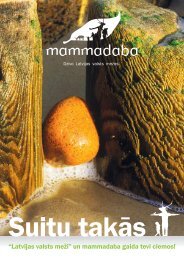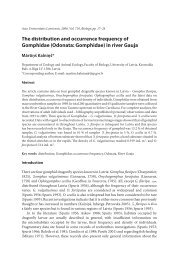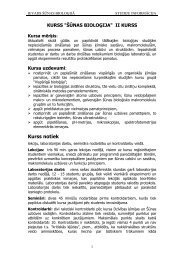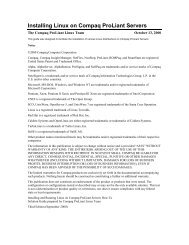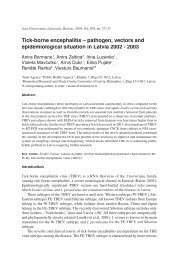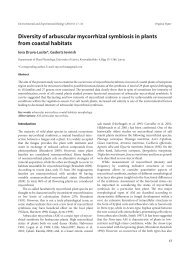Biohydrogen production in anaerobic fluidized bed reactors: Effect of ...
Biohydrogen production in anaerobic fluidized bed reactors: Effect of ...
Biohydrogen production in anaerobic fluidized bed reactors: Effect of ...
You also want an ePaper? Increase the reach of your titles
YUMPU automatically turns print PDFs into web optimized ePapers that Google loves.
3386<br />
<strong>in</strong>ternational journal <strong>of</strong> hydrogen energy 35 (2010) 3379–3388<br />
operat<strong>in</strong>g HRT <strong>in</strong> AFBRs. Attached biomass, EPS prote<strong>in</strong>s, and<br />
EPS carbohydrates were higher for expanded clay particles.<br />
When HRT decreased from 8 h to 2 h, the TVS/expanded clay,<br />
prote<strong>in</strong>/expanded clay, and carbohydrate/expanded clay<br />
ratios <strong>in</strong>creased from 0.711 to 1.100 mg TVS g 1 expanded clay,<br />
from 0.050 to 0.086 mg prote<strong>in</strong> g 1 expanded clay, and from<br />
0.071 to 0.147 mg carbohydrate g 1 expanded clay, respectively.<br />
However, these values dropped to 0.658 mg TVS g 1<br />
expanded clay, 0.070 mg prote<strong>in</strong> g 1 expanded clay, and<br />
0.116 mg carbohydrate g 1 expanded clay, respectively, for an<br />
HRT <strong>of</strong> 1 h.<br />
The same behavior was observed for polystyrene particles.<br />
The TVS/polystyrene, prote<strong>in</strong>/polystyrene, and carbohydrate/<br />
polystyrene ratios <strong>in</strong>creased from 0.519 to 0.805 mg TVS g 1<br />
polystyrene, from 0.031 to 0.061 mg prote<strong>in</strong> g 1 polystyrene, and<br />
from 0.090 to 0.104 mg carbohydrate g 1 polystyrene, respectively,<br />
when HRT decreased from 8 h to 2 h. However, these<br />
values dropped to 0.645 mg TVS g 1 polystyrene, 0.059 mg<br />
prote<strong>in</strong> g 1 polystyrene, and 0.098 mg carbohydrate g 1 polystyrene,<br />
respectively, for an HRT <strong>of</strong> 1 h.<br />
The decreas<strong>in</strong>g TVS/support ratio for polystyrene and<br />
expanded clay particles may have contributed to the reduction<br />
<strong>in</strong> HY values <strong>in</strong> each reactor at the HRT <strong>of</strong> 1 h (Fig. 2). The<br />
<strong>in</strong>creas<strong>in</strong>g OLR (with decreas<strong>in</strong>g HRT) may have <strong>in</strong>creased the<br />
thickness <strong>of</strong> the bi<strong>of</strong>ilm, and therefore attachment to<br />
the support material might have become weaker. As a result,<br />
some bi<strong>of</strong>ilm may have separated from support materials due<br />
to particle–particle collisions, caus<strong>in</strong>g a decrease <strong>in</strong> the<br />
observed values <strong>of</strong> TVS/support, prote<strong>in</strong>/support, and carbohydrate/support<br />
ratios when the highest OLR value was<br />
reached. These effects would subsequently result <strong>in</strong> reduced<br />
HY. Another hypothesis is that once the AFBRs became overloaded,<br />
the systems were limited with respect to glucose<br />
conversion, while the HPR cont<strong>in</strong>ued to <strong>in</strong>crease as the HRT<br />
decreased (OLR <strong>in</strong>creased).<br />
Moreover, the superior performance <strong>of</strong> AFBRs conta<strong>in</strong><strong>in</strong>g<br />
expanded clay (R2) could be credited to the surface characteristics<br />
<strong>of</strong> this support material. The surface roughness <strong>of</strong><br />
expanded clay (18.1%) particles is higher than that <strong>of</strong> polystyrene<br />
(14.6%) particles. Although the polystyrene particles<br />
were previously submitted to chemical treatment to enhance<br />
their surface roughness, the majority <strong>of</strong> their surface area<br />
rema<strong>in</strong>ed smooth. Moreover, expanded clay particles have<br />
more creviced surfaces than polystyrene particles, and these<br />
crevices protect develop<strong>in</strong>g bi<strong>of</strong>ilms from shear forces,<br />
allow<strong>in</strong>g more uniform biomass colonization.<br />
4. Conclusion<br />
Based on the experimental results, we conclude that glucose<br />
fermentation <strong>in</strong> the AFBRs conta<strong>in</strong><strong>in</strong>g polystyrene (R1) and<br />
expanded clay (R2) was adequate for hydrogen <strong>production</strong>. HY<br />
<strong>in</strong>creased <strong>in</strong> R1 and R2 when HRT decreased from 8 h to 2 h.<br />
When HRT decreased to 1 h, the performance <strong>of</strong> the AFBRs<br />
decl<strong>in</strong>ed considerably. R2 had HY values rang<strong>in</strong>g from<br />
1.51–2.52 mol H 2 mol 1 glucose, while the HY values for R1<br />
ranged between 0.90 and 1.90 mol H 2 mol 1 glucose. The<br />
highest hydrogen <strong>production</strong> rate (HPR) values were 0.95 and<br />
1.21 L h 1 L 1 for R1 and R2 with an HRT <strong>of</strong> 1 h. The H 2 content<br />
<strong>in</strong>creased from 16–47% for R1 and from 22–51% for R2 with<br />
decreas<strong>in</strong>g HRT. No methane was detected <strong>in</strong> the biogas<br />
throughout the period <strong>of</strong> operation <strong>of</strong> the AFBRs. It was<br />
possible to verify that larger levels <strong>of</strong> attached biomass and<br />
EPS content on support materials resulted <strong>in</strong> higher HY and<br />
HPR values <strong>in</strong> AFBRs. R2 displayed a more favorable distribution<br />
<strong>of</strong> SMP for hydrogen <strong>production</strong>, with acetic and butyric<br />
acids as the dom<strong>in</strong>ant species. Glucose conversion <strong>in</strong> R2 was<br />
greater than <strong>in</strong> R1, which may be attributed to better surface<br />
characteristics <strong>of</strong> the expanded clay material for biomass<br />
attachment.<br />
Acknowledgments<br />
The authors gratefully acknowledge the f<strong>in</strong>ancial support <strong>of</strong><br />
FAPESP, CNPq and CAPES.<br />
references<br />
[1] Das D, Veziroglu TN. Hydrogen <strong>production</strong> by biological<br />
process: a survey <strong>of</strong> literature. Int J Hydrogen Energy 2001;26:<br />
13–28.<br />
[2] Kapdan IK, Kargi F. Bio-hydrogen <strong>production</strong> from waste<br />
materials. Enzyme Microb Technol 2006;38:569–82.<br />
[3] Lev<strong>in</strong> DB, Pitt L, Love M. <strong>Biohydrogen</strong> <strong>production</strong>: prospects<br />
and limitations to practical application. Int J Hydrogen<br />
Energy 2004;29:173–85.<br />
[4] Lay JJ, Lee YJ, Noike T. Feasibility <strong>of</strong> biological hydrogen<br />
<strong>production</strong> from organic fraction <strong>of</strong> municipal solid waste.<br />
Water Res 1999;33:2579–86.<br />
[5] Mizuno O, D<strong>in</strong>sdale E, Hawkes FR, Hawkes DL, Noike T.<br />
Enhancement <strong>of</strong> hydrogen <strong>production</strong> from glucose by<br />
nitrogen gas sparg<strong>in</strong>g. Bioresour Technol 2000;73:59–65.<br />
[6] Das D, Veziroglu TN. Advances <strong>in</strong> biological hydrogen<br />
<strong>production</strong> processes. Int J Hydrogen Energy 2008;33:6046–57.<br />
[7] Kotay SM, Das D. <strong>Biohydrogen</strong> as a renewable energy<br />
resourcedprospects and potentials. Int J Hydrogen Energy<br />
2008;33:258–63.<br />
[8] Hallenbeck PC. Fundamentals <strong>of</strong> the fermentative<br />
<strong>production</strong> <strong>of</strong> hydrogen. Water Sci Technol 2005;52:21–9.<br />
[9] van G<strong>in</strong>kel S, Sung SW, Lay JJ. <strong>Biohydrogen</strong> <strong>production</strong> as<br />
a function <strong>of</strong> pH and substrate concentration. Environ Sci<br />
Technol 2001;35:4726–30.<br />
[10] Fang HHP, Liu H. <strong>Effect</strong> <strong>of</strong> pH on hydrogen <strong>production</strong> from<br />
glucose by a mixed culture. Bioresour Technol 2002;82:87–93.<br />
[11] Khanal SK, Chen WH, Li L, Sung S. Biological hydrogen<br />
<strong>production</strong>: effects <strong>of</strong> pH and <strong>in</strong>termediate products. Int J<br />
Hydrogen Energy 2004;29:1123–31.<br />
[12] Chen WM, Tseng ZJ, Lee KS, Chang JS. Fermentative<br />
hydrogen <strong>production</strong> with Clostridium butyricum CGS5<br />
isolated from <strong>anaerobic</strong> sewage sludge. Int J Hydrogen<br />
Energy 2005;30:1063–70.<br />
[13] Zhao QB, Yu HQ. Fermentative H 2 <strong>production</strong> <strong>in</strong> an upflow<br />
<strong>anaerobic</strong> sludge blanket reactor at various pH values.<br />
Bioresour Technol 2008;99:1353–8.<br />
[14] Argun H, Kargi F, Kapdan IK, Oztek<strong>in</strong> R. Batch dark<br />
fermentation <strong>of</strong> powdered wheat starch to hydrogen gas:<br />
effects <strong>of</strong> the <strong>in</strong>itial substrate and biomass concentrations.<br />
Int J Hydrogen Energy 2008;33:6109–15.<br />
[15] Wang CH, Chang JS. Cont<strong>in</strong>uous biohydrogen <strong>production</strong><br />
from starch with granulated mixed bacterial micr<strong>of</strong>lora.<br />
Enegy Fuels 2008;22:93–7.





